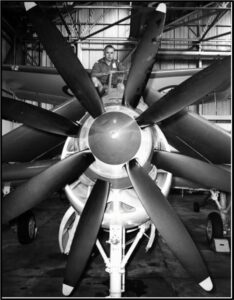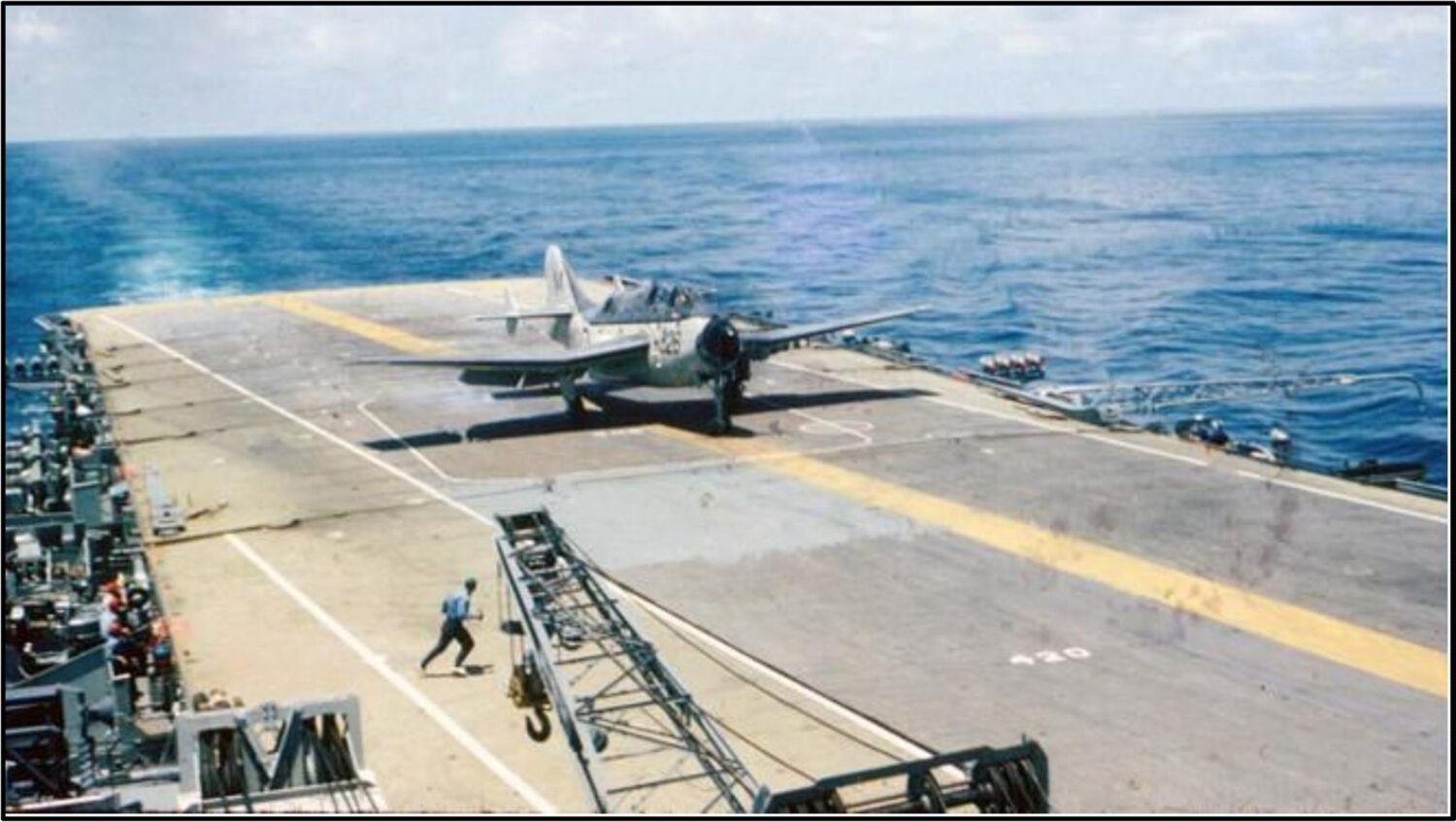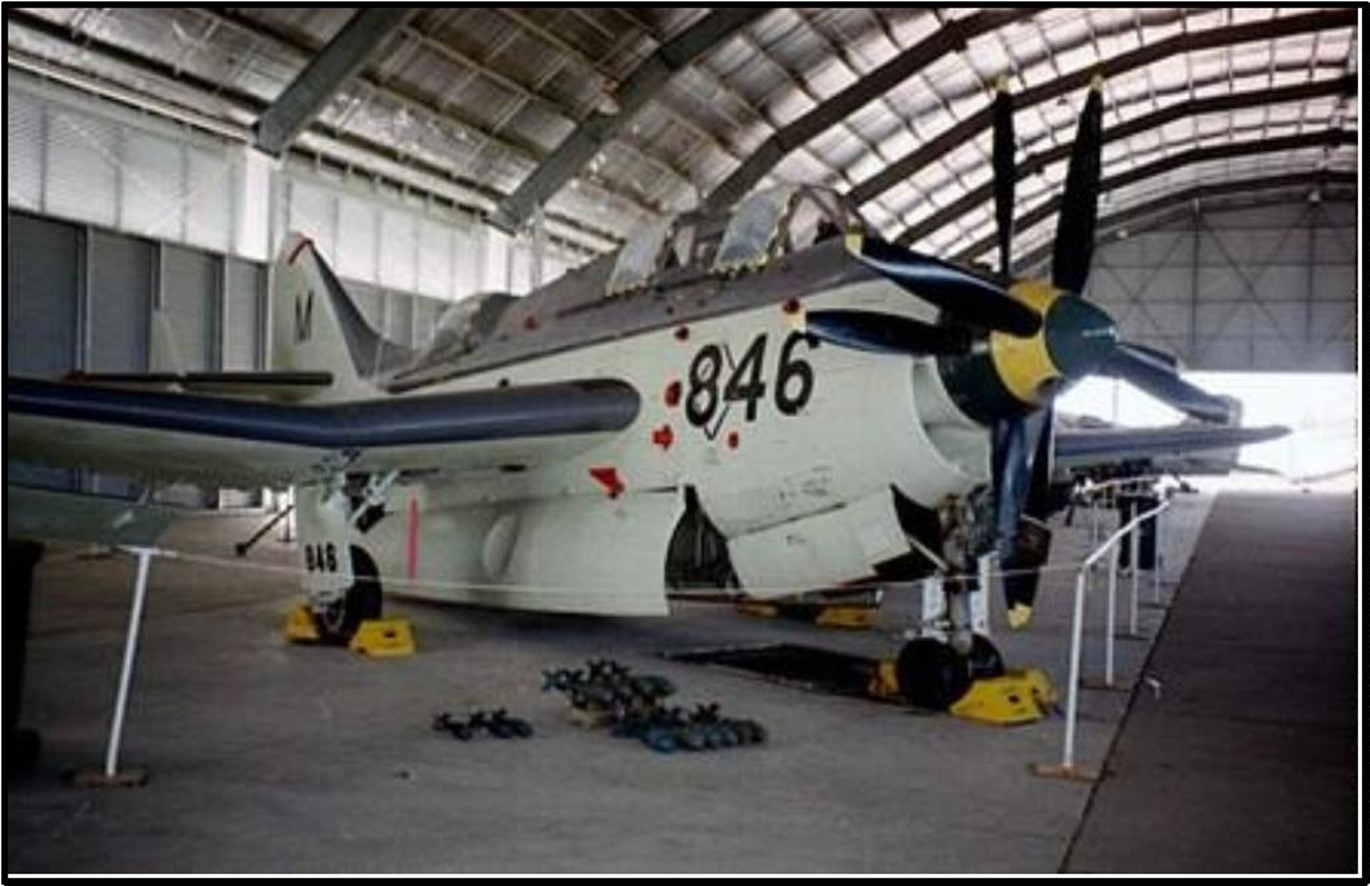| By CMDR (P) R. V. Morritt,RAN Rtd |
| The Fairey Gannet A/S 1 aircraft was introduced into the Royal Australian Navy(RAN) Fleet Air Arm (FAA) in 1955. When embarked in the newly acquired HMAS Melbourne, Australia’sNaval Air Anti-Submarine power during the fifties and sixties was the most modern and technicallyadvanced in the whole of South East Asia. |
| Not a ‘glamour’ aircraft by any stretch of the imagination, the Fairey Gannet wasperhaps one of the most interesting at that time. Its unique engine arrangement, mission profile andcapability, and large size and beautiful inverted gull wing still attract admiration and attention from aviationaficionados and enthusiasts alike. A twin turbo-propeller aircraft; it was fitted with an Armstrong-Siddeley Double Mamba turbine engine, driving the contra-rotating propellers via a central shaft and gear box, which in turn was lubricated by engine oil from a single oil supply tank. Herein lay one of the two stings in thetail of the Gannet upon which I shall enlarge a little later. |
| I seemed destined to set off a string of ‘firsts’ when, in 1953, having beenselected for National Service Training, our course would be the first to undergo Flying Training, and I wasselected in this first training group to be trained on Tiger Moths to Private Pilot License standard. Uponcompletion of NST I decided to join the RAN Fleet Air Arm and continue training to Wings standard. Upongraduation, I was awarded the Weapons trophy and the Goble Trophy for the Most Proficient Pilot on course.Having been trained in the Tiger Moth, followed by Wirraway, Firefly Mk V1 and Sea Fury FB11 aircraft, the shock and awe upon being confronted by the increasing size and complexity of each succeeding modelwas difficult to overcome. However, the sheer bulk of the Gannet was something to beholdwhen standing next to it trying to work out how to gain entry to the cockpit! |
| It had a crew of three, pilot in front of course, Observer (Navigator/Tactical operator) in the center cockpit, and Radio Operator in the rear cockpit – facing rearwards. The fuselage was ahuge, slab-sided affair with the cockpit some ten feet above the ground. Entry was by means of a three-stepladder, which was lowered and raised by hand, followed by a series of indented foot/handholds ascending in a large diamond pattern. When commencing training on this aircraft the very first lesson was toestablish which foot to place in the lowest step in order to ascend successfully into the required cockpit! Start with the wrong foot and one could easily find oneself led into the wrong cockpit. One could only undo thiserror by descending and re-commencing with the correct foot! |
| When embarked, the Gannet aircraft routinely averaged sortie times of around 3-4 hours. Anti-Submarine equipment was not much more than theMK1 Eyeball! A basic radar (ASV19B), a mix of mainly non-directional and a small number of directional sonobuoys, and a small number of hand launched smoke markers completed the A/S detection kit. It was also possible to carry two homing torpedoes, a few depthcharges or a small number of 250 lb. bombs either in the bomb bay or on wing racks, and occasionally 60lbrockets. That completed the ASW capability. |
| Engine failures |
 Standard operating procedure called for normal cruise configuration to be on single engine in order to conserve fuel. Anti-submarine search operations were routinely below 1500 feetin all weather, day and night. The single-engine cruise protocols called for the operating engine to beswapped hourly in order to even out the running hours. Operations were normal for the first year or twoutilizing the above-mentioned protocols. However, it was not long before aircraft began suffering enginefailures at a disturbing frequency, almost always preceded by a rapid loss in oil pressure. This resultedin an increase in single engine deck landings, something to which pilots did not look forward, particularlyin heavy seas and/or bad weather. Eventually Fairey Aviation discovered that the prolonged single enginecruising was causing Brinelling’, or pitting, of the propeller bearings in the feathered propeller. This inturn was causing metal particles to be distributed through the oil into both engines and propellers due tothe single oil supply tank the first of the two stings in the Gannet tail! Standard operating procedure called for normal cruise configuration to be on single engine in order to conserve fuel. Anti-submarine search operations were routinely below 1500 feetin all weather, day and night. The single-engine cruise protocols called for the operating engine to beswapped hourly in order to even out the running hours. Operations were normal for the first year or twoutilizing the above-mentioned protocols. However, it was not long before aircraft began suffering enginefailures at a disturbing frequency, almost always preceded by a rapid loss in oil pressure. This resultedin an increase in single engine deck landings, something to which pilots did not look forward, particularlyin heavy seas and/or bad weather. Eventually Fairey Aviation discovered that the prolonged single enginecruising was causing Brinelling’, or pitting, of the propeller bearings in the feathered propeller. This inturn was causing metal particles to be distributed through the oil into both engines and propellers due tothe single oil supply tank the first of the two stings in the Gannet tail! |
| The quick fix was to change the single engine cruise protocol to ensure equal distribution of the time in the feathered position; rotating the feathered engine slightly every ten minutes, and changing operating engines every 30 minutes. All this had to be accomplished while possibly activelytracking a submarine, often at 300 feet on a pitch-black night and possibly in bad weather – and no co-pilot to assist! There were many single engine landings, both day and night on board Melbourne, caused almost exclusively by this problem. This was worrying enough without the knowledge in the back of thepilot’s mind that the pieces of metal in the joint oil supply could result in the second engine failing at any time!Many times the pilots missed the wires due to float, deck movement or both – resulting in a BOLTER.However, on 6 June 1958, on completion of a night flare dropping exercise, I again experienced an enginefailure – which resulted in a dreaded night BOLTER followed by a successful recovery. Another ‘first’. |

| Landing on HMASMelbourne 1958 |
| NightBOLTER |
| It was a very warm night in South East Asia and the sea was relatively flat withonly about 10 knots of wind. Having suffered what was now a routine engine failure, I elected to perform astraight in landing. This was probably an error in that it caused difficulties in attaining and holding the correct approach speed, such that the aircraft was approximately 5 knots fast over the round-down and floated overall the arrestor wires. I immediately applied full power to the operating engine and raised the undercarriage but was unable to climb away. The aircraft settled towards the water but held altitude just above thesurface in the ground effect. The altimeter was reading zero, and the needle on the Radar Altimeter,calibrated in 10 feet increments, was hovering just above zero – but not even half way to the 10 feet marker. As the aircraft passed down the port side of the Rescue Destroyer stationed on the StarboardBow of the Carrier, the Port Running Light on the bridge was above the eye level of the crew in the Gannet.After what seemed an eternity, the Radar Altimeter began reading a healthy 50 feet above the water, and raising the flaps was commenced in stages. A very wide, climbing circuit was established, levelling at1,000 feet down-wind.
From there, a normal single-engine landing was completed, followed by severalmedicinal rums in the sick bay afterwards! This was the first and only successful night bolter and recovery ever in either the RAN or RN. I believe it remains so to this day. My crew comprised Lieut. Evans(Observer) and Obs. 1 Hancox (Tel). |
| Sting in thetail |
| Getting back to the Gannet peculiarities, the second sting in its tail – which caused many accidents and injuries, including death – was a little thing called the Flight Fine Pitch Stop.Essentially, this was a pin which prevented each propeller from moving into the fully fine position when the throttles were retarded as for landing, unless the landing gear was down and locked. This stop wasactuated (inserted) by the landing gear coming up, and removed by it on lowering for landing. When the propellerswere allowed the full movement into the full fine position, they effectively presented two solid disks tothe airflow, causing enormous drag and potential for uncontrollable loss of altitude. Of course, thiswas of little concern when at altitude or when within inches of the ground in the normal landing with the geardown. However, in the single engine configuration, this drag was not at all desirable – so there were two Flight Fine Pitch Stop Override (FFPSO) switches in the cockpit with which the withdrawal of these pins(one on each propeller) was prevented, either individually or together when the landing gear was lowered.Of course, when attempting a single engine landing, the lack of this drag in the final landing phase(assuming the pilot had remembered to make the FFPSO switches) could result in a float before touchdown. This was of no consequence when landing on a runway – but caused untold difficulties in the finalphase of a deck landing! It was invariably this, in association with possible deck movement, which caused the aircraft to float over the wires and BOLTER! |
| The ability of the Gannet to fly around at low level on one engine with hookdown, bomb-bay doors open and radome lowered made the aircraft a great crowd pleaser at flying displays.This act was sometimes varied by turning down wind at the end of the runway after the low fly-past, closing the bomb-bay doors, raising the hook and radome while in the turn, and then lowering theundercarriage to complete a single engine landing as a finale. This always impressed the crowd. However, had thepilot not taken the precaution of selecting the FFPSO ON for the live engine, the lowering landinggear withdrew the FFPS – with the resulting uncontrollable drag and inevitable catastrophic crash! This occurred at NAS Nowra on one occasion, and resulted in very serious injury to the Gannet pilot. Thisaccident resulted in such demonstrations being banned in the RAN. |
| One-wingsalute |
| The odd double vertical folding arrangement for the wings made for quite smallground coverage, but a need for lots of headroom. It did, however, lend itself to inventive initiative attimes. Admiral’s inspection at NAS Nowra was always a painful day – and one to be dreaded. Very rare was theday when the inspecting Admiral was not displeased about something. On one particular occasion a flightof Gannets provided a short air display for the Admiral’s benefit. Upon landing, the four taxiing Gannetspassed in front of all the Divisions drawn up on the Hard Stand with the Admiral waiting for them to marchpast in salute. An astute Air Engineering Officer of the Gannet Squadron had disabled the folding mechanism of the port wing in all the four aircraft prior to take-off. As the flight passed the Admiral in line asternformation, the leader ordered the flight to ‘fold wings’. Lo and behold, all starboard wings folded as one in salute to the Admiral, and then spread again after passing the dais! The Admiral was so pleased that hegave the Air Station full marks for their inspection (so the story goes). |
| Notwithstanding all that has been said, the Gannet was a delight to fly, very lighton the controls, very manoeuvrable, with excellent visibility from the very roomy cockpit. Like thealbatross and the pelican, which look most ungainly when on the ground, the Gannet was in its elementonce it shook itself free of the ground and soared into the air. As described by one pilot ‘it was like the fat ladyat the barn dance, whoyou find surprisingly light on her feet, that is how it flew. ’
|
| Note: Originally published in December 2011 edition of the Naval Historical Review (all rights reserved),
available at, https://www.navyhistory.org.au/the-fairey-gannet-as1/ |

